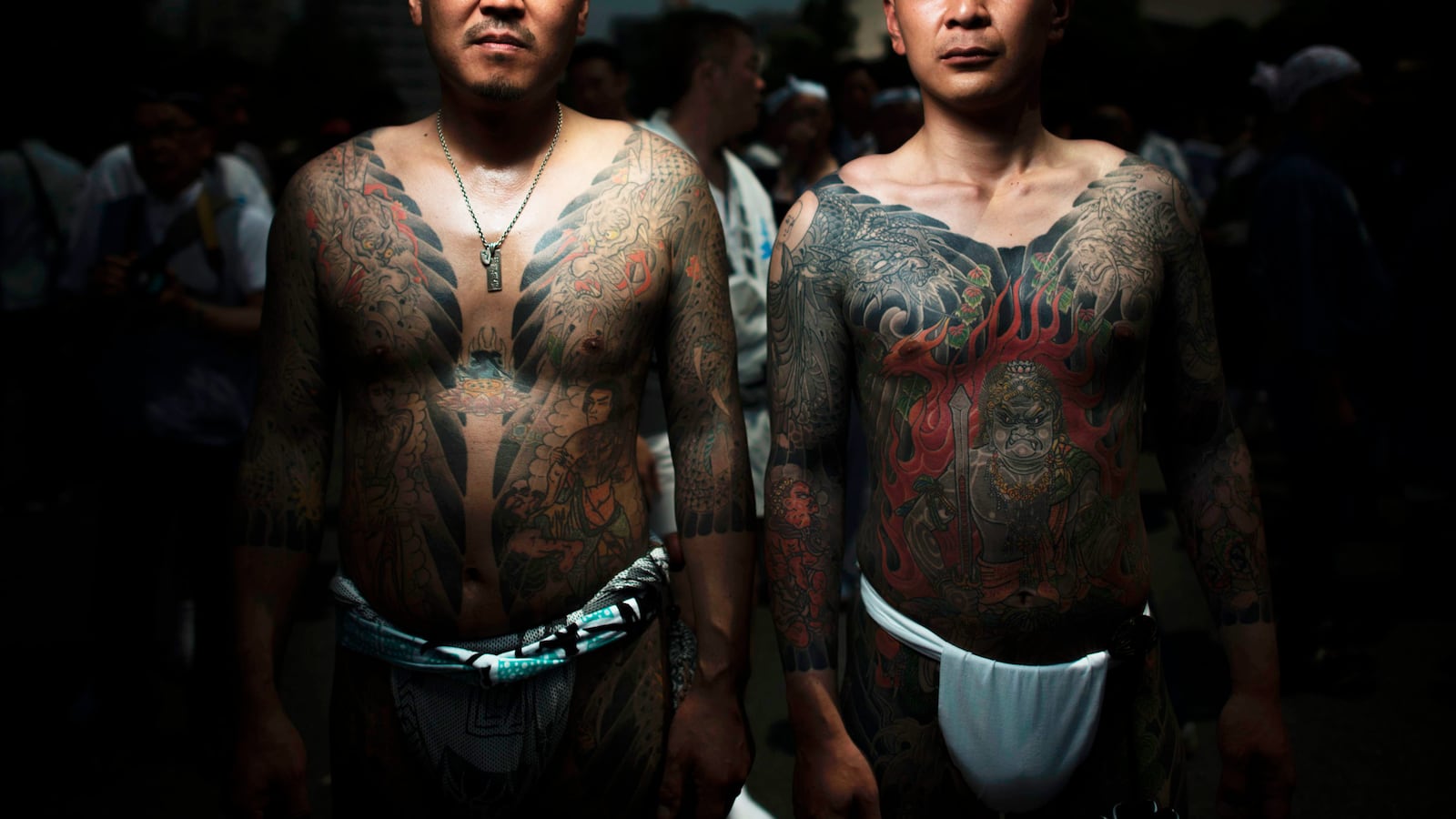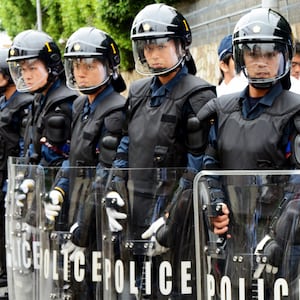It’s not often that kids get to shake down gangsters for candy—but up until this Halloween, the neighborhood children in Kobe, Japan, got to terrorize the local yakuza (Japanese mafia) with a raucous “Trick or Treat!” And the yakuza, by all accounts, loved it. For years, both thugs and kids looked forward to the annual Halloween festivities at the headquarters of Japan’s largest mob group.
The Yamaguchi-gumi, the country’s largest crime group, discovered Halloween by accident when international school students trick-or-treated their offices decades ago. What started as an awkward offering of cash from gangsters to appease the local kids turned into a time-honored neighborhood celebration.
That decades-long tradition has ended this year. But “Yakuza Halloween” wasn’t canceled because of COVID-19—instead, laws passed by the Hyogo Prefecture Assembly this month now forbid gangsters from giving candy (assets) to children, or allowing them onto their property.
There are certainly good reasons for forbidding the yakuza from associating with the neighbors and their children, but it has left a lot of the locals feeling more tricked than treated.
No Need For Masks
In Japan, the yakuza are not hidden and while they may be wearing masks now due to the COVID-19 pandemic, usually they don't go to the trouble of hiding their scary faces. They exist legally, although they are regulated. The Yamaguchi-gumi headquarters and the headquarters of the other yakuza groups like the Inagawa-kai are public record; they are listed on the Japanese National Police Agency website. Until last year, monthly fanzines documented the exploits of the yakuza past and present, as do periodically issued comic books. The Yamaguchi-gumi, founded in 1915, has been in business over a century and still has numerous legitimate and illegitimate companies dealing in real estate, construction, and entertainment.
Despite cultivating a benevolent samurai image, most yakuza derive their revenue from racketeering, gambling, fraud, insider trading, blackmail and other unsavory acts. Many members also run legitimate businesses. The Yamaguchi-gumi claims to be a humanitarian organization, and ostensibly forbids its members from engaging in theft, robbery, drug dealing, and street crimes. This may be one reason they have been tolerated for so long.
The Yamaguchi-gumi Headquarters in Kobe, observing the practical precept of “don’t shit where you eat,” has a long history of getting along with the people living close by. They are well-behaved. This may be a way of discouraging civil lawsuits to have them removed from the area, but to be fair, it’s also because the gangsters, living and working there, like the residents. Almost every New Year, they hold a rice-cake making ceremony and invite the locals to come. The top-dogs of the Yamaguchi-gumi also participate.
In recent years, the festivities have been sporadic.
On Aug. 27, 2015, the Yamaguchi-gumi was split apart when the Yamaken-gumi faction and 12 other factions declared independence, creating the Kobe Yamaguchi-gumi. It was the start of a bloody gang war that has boiled over many times since then. The Kobe Yamaguchi-gumi itself split apart, resulting in the emergence of a third group, the Ninkyo Yamaguchi-gumi (currently Kizuna-kai).
Despite the internal conflict, the Yamaguchi-gumi has continued to wage a PR war with the public. It’s obvious that providing swift aid after natural disasters is good yakuza public relations and so is holding annual events like the Halloween bash.

A man poses for photographs showing his "Irezumi" Japanese traditional tattoos related to the Yakuza's universe, during the Sanja Matsuri festival in Tokyo.
AFP PHOTO / FRED DUFOUR/ GETTY / GettyThe Halloween tradition started sometime during the reign of the 3rd Generation leader of the Yamaguchi-gumi—known as “The Godfather of Godfathers,” Kazuo Taoka—in the late 1970s. During that period, children from a local international school, dressed as ghosts and witches, came trick-or-treating, pounding on the door of the headquarters. At first, a puzzled, slightly scared gangster shooed them away with 1,000 yen bills ($10). The kids kept coming back every year. Taoka ordered his troops to study Halloween and learn how to appease the tiny barbarians at the gate. Gradually, the Yamaguchi-gumi learned that it was better to give the kids candy and presents than cash and started to become fond of the yearly interaction. The fifth-generation leader of the Yamaguchi-gumi, Yoshinori “The Gorilla” Watanabe, institutionalized the Halloween party. By 2016, there were roughly 700 children attending, and about 300 parents and guardians coming every year.
A former low-ranking member of the Yamaguchi-gumi, Yu Nakajima, told The Daily Beast that he enjoyed the Halloween party almost as much as the children. “At first, I was a little nervous. You’ve got these really loud foreign kids and some Japanese kids running around saying, “Trick or treat!” Once I understood what Halloween meant and the tradition, it was less weird. And it is kind of heartwarming to see the smile on the faces of the little rugrats when you give them a bag of candy.”
The decorations and stuffing the bags full of candy would take several days to prepare. In addition, sometimes temperatures reached near-freezing levels outside the buildings in late October, making the preparation a tiresome task. “I’m sure some brothers left at HQ are glad the tradition is coming to an end; it’s a pain in the ass. But I think many will miss being greeted with smiles. We’re not in a business where people smile at us much, or we smile back.”
The Untold Story Of The Great Trick-Or-Treat Of 2017
The annual event was first called off in 2015, when the gang wars began. In 2016, they restarted the festivities.
However, in 2017, there was a note placed on the door of the headquarters notifying the neighborhood that Halloween would be canceled. It read, roughly translated: “Every year on Oct. 31, we have held the traditional Halloween [party]. However, this fiscal year, due to a number of various circumstances, we will be halting the event. We understand that we are making the children who were looking forward to this very sad, but next year we absolutely will hold the event, so please look forward to it. Thank you for allowing us to inform you.”
The Japanese media reported quickly that there would be no yakuza Halloween that year.
The sign on the door? It turned out to be a grand trick. There was a yakuza Halloween, after all. The Yamaguchi-gumi outwitted their rivals, fooled the police, and surprised and delighted the neighborhood children by holding it anyway.
At around 4pm on Oct. 31, gangsters opened the shutters of their headquarters and began distributing bags of candy to the neighborhood kids, as they had done for decades. The children were invited to come inside and join the party. Each garish bag of treats was decorated with jack-o-lanterns and “Happy Halloween” in English. The bags had cookies, crackers, and chocolate-filled koalas.
“They did celebrate this year and their set-up (was) super,” said one local woman at the time. “Big bags with goodies and two big lines for cotton candy. And the gangsters were super nice!” The gang members decorated the inside of their headquarters with pumpkins and Halloween lights, blow-up ghost dolls, and distributed the bags of candy to the kids saying, “Happy Halloween!”
One gangster dressed as a giant Jack-O-Lantern greeted people at the doors; others in bullet-proof vests patrolled the area as the police looked on. A young mother who brought her two sons to the event said, “Between the police and the gangsters, I think this is a very safe place to be. Good security and good fun.”
It was a happy day in Kobe that Halloween in 2017; it was less happy in Tokyo that same day, where the police found nine dismembered bodies in the apartment of an accused serial killer who is still on trial for murder.
There are things scarier than gangsters.
For those living close by, the Yamaguchi-gumi members don’t always seem very scary. For the rest of the world, the Japanese mafia are frightening creatures. I’ve been reporting on them since 1993 and I still get nervous when I have to deal with them. They don’t wear masks but many of them wear sunglasses and are covered in ornate tattoos, often with violent images, and have a characteristic scowl. Some members are missing fingers, sometimes several. A yakuza will cut off a finger in atonement for their own mistakes or on behalf of their friends to settle a dispute. A chopped-off finger to atone for your mistakes is known as a shiniyubi, aka “a dead finger.” When a pinkie is sacrificed for another person, it’s the more honorable ikiyubi, aka a “living finger.”

Silicone-made fingers and limbs are displayed on a work bench at prosthetics office in Tokyo. Going straight after a lifetime spent as a member of Japan's feared yakuza organised crime mobs poses a number of challenges. Chief among them is what to do about the fingers you chopped off.
TOSHIFUMI KITAMURA/AFP via Getty ImagesMany older yakuza also have facial scars. This dates back to a time when instead of killing a rival, some thugs would just cut the person’s face and let them live. A small number of yakuza deliberately cut their own faces, to give the impression that they had survived a deathly confrontation. In Japan, to discreetly discuss the yakuza without saying the word “yakuza,” some people still use their index finger to pantomime cutting their face.
However, to the kids coming to the Halloween party, the yakuza don’t seem scary at all. Maybe that’s what a sugar high does for you.
In the end, the 2017 surprise was greeted warmly by the people actually attending.
A father in the area of Indian descent said, “The kids got one bag each, worth about 1,000 yen ($9) worth of stuff. My wife said the decorations were great.” Many in the large Indian community in Kobe were convinced that they played a role in the tradition, recounting stories of visiting the headquarters in their youth. Some claimed that the Japanese kids began to imitate them on their trick-or-treating rounds, but the Japanese kids, lacking costumes, would just wear black garbage bags.
However, public opinion holds that “yakuza are always evil” and so no one wants to go on record as a defender of the local thugs.
The police were less than delighted with the “trick”. An organized crime control detective from the Kansai area said at the time, “We weren’t completely caught off guard but it was a dangerous move in light of the current gang war. I think their rivals were snow-jobbed, so that was kind of amusing.”
In 2018, the celebration was held again, much to the chagrin of the police. However, last year, due to a heat-up in the battles between the three groups claiming the right to the Yamaguchi-gumi mantle, Halloween was once again called off.
There wouldn’t have been a Yakuza Halloween this year… even without COVID-19
It is highly dubious that there would have been a Halloween party this year, even if we were not in the middle of a pandemic.
The Yamaguchi-gumi were declared a “specially dangerous organized crime group” by the authorities early this year, when the Tokyo 2020 Olympics were due to be held, and the use of their offices has been banned. This wasn’t enough for the police and the authorities who pushed for changes in the Hyogo Prefecture organized crime exclusionary ordinance. The Hyogo Prefecture Assembly approved the new changes in early October which ban any yakuza group from offering “money and goods” to children, contacting juveniles under 18, or allowing kids into the offices. Those violating the ordinance are given a warning and repeated violations result in up to six months in jail and/or a fine of 500,000 yen ($4,780)
The ordinance went into effect on Oct. 26. The ostensible reasons for the revisions are to prevent youngsters from admiring the yakuza, fraternizing with them, and later becoming gangsters.
It is true that the Yamaguchi-gumi and all the yakuza groups in Japan could use some young blood; the average yakuza is now aged 50. (I’m 51 myself, but probably within an acceptable age range to join the tribe if this job doesn’t pan out.)
Satoru Takegaki, a former Yamaguchi-gumi boss who now runs a non-profit organization that helps rehabilitate ex-yakuza, in an interview with weekly magazine Shukan Shincho, acknowledged the ban made some sense. But he also added, “Ever since the days of the Godfather (Kazuo Taoka), the organization has tried to make some contribution to society. That includes helping out after the Great Hanshin earthquake in 1995 and the Tohoku earthquake in 2011.”
Yes, Takegaki understands that the candy may have been bought with proceeds from illegal enterprises and ultimately the same could be said of other charity work the yakuza have done. But…“There aren’t many good things that a yakuza can do with some pride.” And he believes that knowing one is contributing to society, and finding joy in that, is the first step in social rehabilitation.
Former yakuza underling Nakajima agrees. “Getting rid of Halloween won’t make the local kids any less afraid of the yakuza, but ultimately, it might make the yakuza more scary. Because little events like this are part of the checks and balances between yakuza and the community. And now one of those checks is gone.”
There won’t be any trick-or-treaters at the Yamaguchi-gumi headquarters this year, or next year. Or the year after that. For the kids who live in the Yamaguchi-gumi neighborhood, unaware of the politics and benevolent thoughts involved in banning their interaction with the gangsters, they know only one thing: Halloween 2020 is going to suck.



